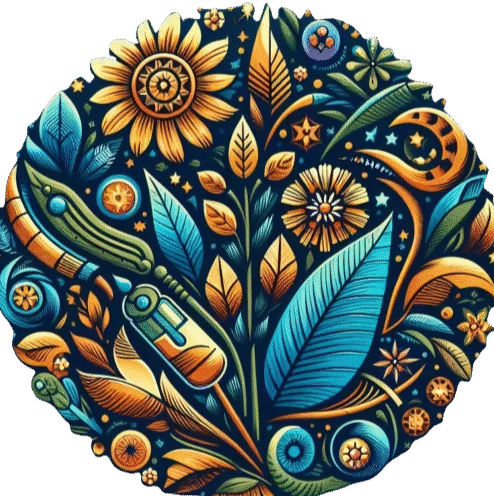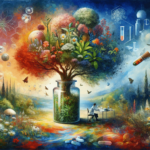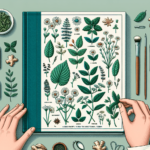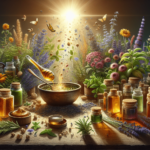Imagine stepping into your garden and being surrounded by a vibrant oasis of healing. From the rhythmic sway of lavender to the delicate petals of echinacea, the power of plants to restore and rejuvenate is truly remarkable. In this article, we will explore the transformative effects of nature’s pharmacy, as your garden becomes a sanctuary for both body and soul. Get ready to be captivated by the healing power of plants that lie just beyond your doorstep.
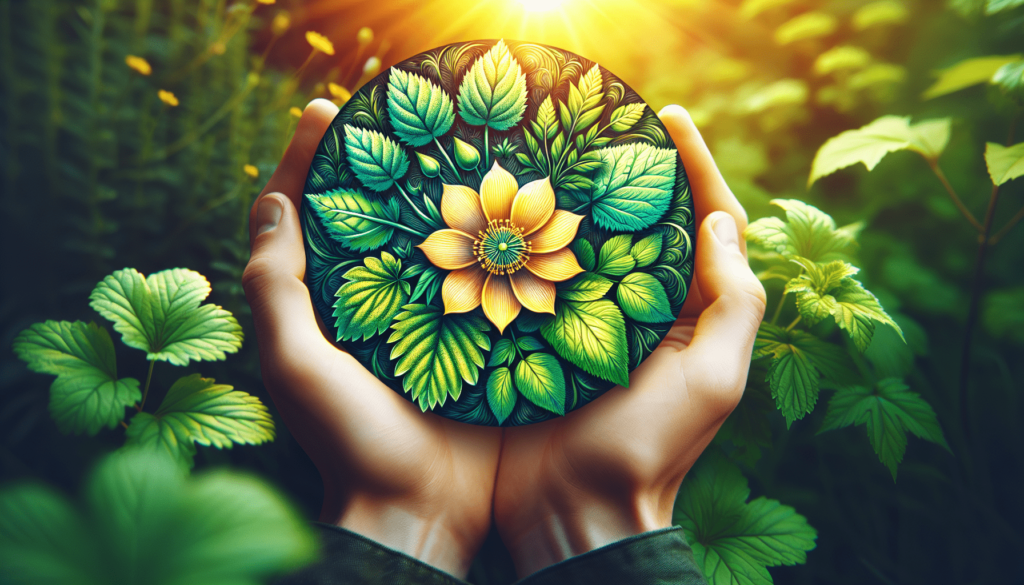
1. Introduction to Healing Plants in the Garden
Benefits of having healing plants in your garden
Having healing plants in your garden not only adds beauty and fragrance to your outdoor space but also provides numerous benefits for your overall well-being. These plants, also known as medicinal plants or herbs, have been used for centuries for their therapeutic properties. By incorporating healing plants into your garden, you can have easy access to natural remedies, promote a healthy lifestyle, and create a peaceful and calming environment.
The history and use of healing plants
The use of healing plants dates back to ancient civilizations, where people relied on plants for their medicinal properties. Traditional healing systems such as Ayurveda, Traditional Chinese Medicine, and Native American healing practices have long recognized the power of plants in promoting wellness. Throughout history, different cultures have utilized various plants to treat ailments, cure diseases, and improve overall health. The knowledge and wisdom behind the use of healing plants have been passed down through generations, highlighting their importance in human well-being.
Exploring the connection between humans and plants
Plants have an amazing ability to connect with humans on a deeper level. The process of nurturing and tending to plants not only fosters a sense of responsibility but also provides a unique opportunity for self-reflection and mindfulness. By cultivating healing plants in your garden, you establish a direct connection with nature and create a harmonious bond with these living beings. The act of gardening can be therapeutic in itself, giving you a sense of purpose and fulfillment as you witness the growth and development of your plants.
2. Types of Healing Plants
Medicinal herbs
Medicinal herbs are one of the most common types of healing plants found in gardens. These herbs are known for their various medicinal properties and have been used for centuries to treat specific ailments or promote overall health. Examples of medicinal herbs include echinacea, chamomile, and St. John’s Wort. These herbs can be dried and used in teas, tinctures, or poultices for their healing benefits.
Aromatic plants
Aromatic plants are another category of healing plants that add fragrance and beauty to your garden. These plants possess a strong scent that can have a therapeutic effect on your well-being. Lavender, rosemary, and mint are popular examples of aromatic plants that can be used for their calming and relaxing scents. Simply being in the presence of these plants can help reduce stress, improve sleep, and uplift your mood.
Edible plants with healing properties
Many edible plants not only provide nourishment for your body but also possess healing properties. Incorporating these plants into your garden allows you to have a fresh and readily available source of nutrition and medicine. Aloe vera, for example, is a succulent plant that can be consumed for its soothing properties on the digestive system and skin. Other edible healing plants include Calendula, lemon balm, and thyme, which can be used in cooking or as herbal remedies.
Flowering plants with therapeutic benefits
Flowering plants not only add vibrant colors and beauty to your garden but also offer therapeutic benefits. These plants are often used in traditional medicine for their medicinal properties. Calendula, with its bright orange or yellow flowers, has anti-inflammatory and skin-soothing properties. Chamomile flowers can be used to make a calming tea that aids in relaxation and sleep. By including flowering plants in your garden, you can enjoy their visual appeal while also reaping the benefits of their therapeutic qualities.
3. Creating a Healing Garden
Choosing the right location for your healing garden
When planning to create a healing garden, it is important to choose the right location that meets the needs of your plants. Most healing plants require ample sunlight, so selecting an area that receives at least six hours of direct sunlight is crucial. Additionally, ensure that the location has good drainage to prevent waterlogging, as excessive moisture can lead to root rot and other plant diseases.
Designing and planning the layout
Designing the layout of your healing garden is an exciting process that allows you to express your creativity while considering the needs of your plants. Consider the height and growth habit of each plant to ensure they are placed in an arrangement that allows for proper growth and easy accessibility. Grouping plants with similar sunlight, watering, and soil requirements can make maintenance easier and promote a healthier garden.
Considerations for container gardening
If space is limited or you prefer a more portable approach, container gardening is an excellent option for growing healing plants. Choose containers that provide adequate drainage and are large enough to accommodate the root system of each plant. This allows for proper airflow and prevents the risk of root rot. Additionally, container gardens can be placed strategically to optimize sunlight exposure or moved indoors during extreme weather conditions.
Essential elements for a healing garden
To create a truly healing garden, consider incorporating elements that enhance the overall experience. Pathways made of natural materials such as gravel or stepping stones can create a serene and inviting atmosphere. Adding a seating area allows you to fully immerse yourself in the beauty and tranquility of your garden. Installing a water feature, such as a small pond or a fountain, can provide a soothing and calming effect with the sound of running water. Finally, including plants with different textures, colors, and scents creates a sensory-rich environment that stimulates the senses and promotes relaxation.
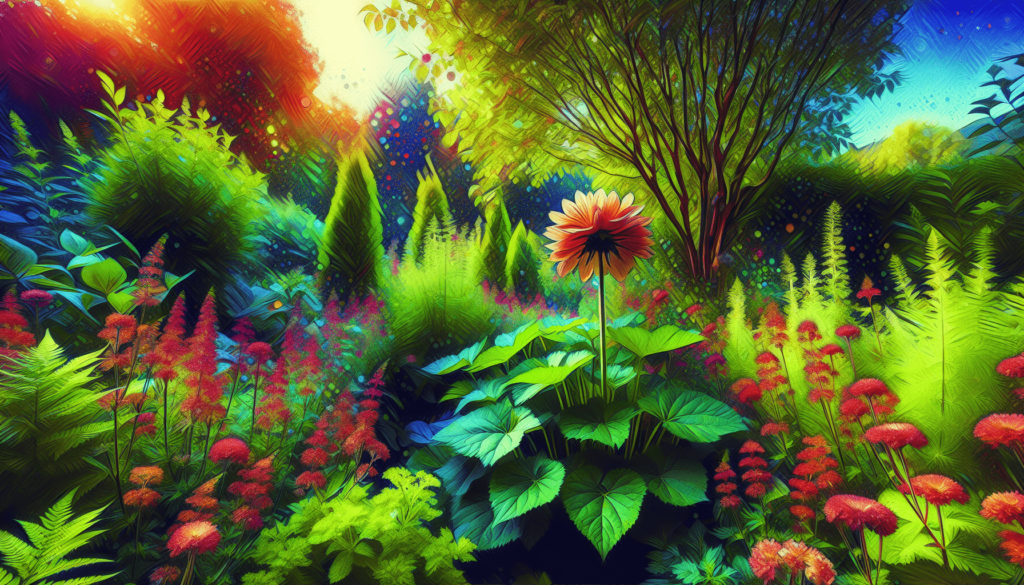
4. Top Healing Plants to Include in Your Garden
Aloe vera
Aloe vera is a well-known healing plant that has been used for centuries for its medicinal properties. It has soothing and cooling properties that make it an effective remedy for burns, skin irritations, and minor cuts. Aloe vera can be grown in pots or in the ground and requires well-draining soil and bright sunlight.
Lavender
Lavender is a popular aromatic plant that not only adds a beautiful fragrance to your garden but also has numerous therapeutic benefits. Its calming scent helps reduce stress, anxiety, and insomnia. Lavender can be grown in containers or in the ground, requiring well-drained soil and full sun.
Echinacea
Echinacea, also known as purple coneflower, is a flowering plant that boosts the immune system and helps fight off colds and infections. It is a hardy plant that thrives in well-drained soil and full sunlight. Echinacea is often used to make teas, tinctures, and herbal remedies.
Mint
Mint is a versatile healing plant that is easy to grow and has a refreshing and invigorating scent. It aids in digestion, relieves headaches, and soothes muscle pain. Mint can be grown in containers or in the ground but tends to spread quickly, so it’s best to keep it contained to prevent it from taking over your garden.
Chamomile
Chamomile is a flowering herb with gentle sedative properties, making it excellent for promoting relaxation and sleep. It can be brewed as a calming tea or used topically to ease skin irritations. Chamomile prefers well-drained soil and full sun to partial shade.
Rosemary
Rosemary is an aromatic herb that is known for its culinary uses as well as its healing properties. It has antioxidant and anti-inflammatory properties and can improve memory and concentration. Rosemary requires well-drained soil, full sun, and thrives in a Mediterranean climate.
Calendula
Calendula, also known as pot marigold, is a flowering plant with anti-inflammatory and skin-soothing properties. It can be used topically to heal wounds, relieve skin irritations, and as a natural remedy for various skin conditions. Calendula prefers well-drained soil and full sun.
Lemon balm
Lemon balm is a citrus-scented herb that has a calming effect on the nervous system, making it useful for reducing stress and anxiety. It can be brewed as a tea or used in aromatherapy. Lemon balm prefers well-drained soil and partial shade.
St. John’s Wort
St. John’s Wort is a flowering plant that has been used for centuries to treat depression and alleviate mild to moderate anxiety. It can be brewed as a tea or taken as a supplement. St. John’s Wort prefers well-drained soil and full sun.
Thyme
Thyme is an aromatic herb with antiseptic properties that can help relieve respiratory congestion, coughs, and sore throats. Thyme can be grown in containers or in the ground and requires well-drained soil and full sun.
5. Caring for Healing Plants
Watering and irrigation tips
Proper watering is essential for the well-being of healing plants. Most healing plants prefer to be watered when the top inch of soil is dry to the touch. Avoid overwatering, as this can lead to root rot and other issues. Using a watering can or drip irrigation system can allow for precise watering and prevent waterlogged soil.
Soil requirements
Healing plants thrive in well-drained soil that is rich in organic matter. A loose and crumbly texture allows for proper root growth and prevents water stagnation. If the soil in your garden is heavy or clay-like, amend it with compost or other organic matter to improve drainage and fertility.
Sunlight and shade considerations
Most healing plants require ample sunlight to grow and thrive. Full sun exposure typically means at least six hours of direct sunlight per day. However, some plants, like chamomile and lemon balm, can tolerate partial shade. It’s important to understand the sun requirements of each plant and place them accordingly in your garden.
Feeding and fertilizing guidelines
Healing plants generally do not require heavy fertilization but can benefit from regular feeding to promote healthy growth. Organic fertilizers, such as compost or well-rotted manure, can be applied during the growing season. It’s important to follow the specific fertilization recommendations for each plant, as overfertilization can be detrimental to their health.
Pest and disease management
Like any other garden plants, healing plants can be susceptible to pests and diseases. Regularly inspecting your plants for signs of infestation or disease can help you address any issues in a timely manner. Using organic pest control methods, such as neem oil or insecticidal soap, can effectively manage common garden pests while minimizing the use of harsh chemicals. Proper sanitation practices, such as removing dead leaves and debris, can also help prevent disease outbreaks.
6. Harvesting and Utilizing Healing Plants
Knowing the right time to harvest
The timing of harvest is crucial for maximizing the medicinal properties of healing plants. Different parts of the plant, such as leaves, flowers, or roots, may be harvested at different stages of growth. Generally, it is best to harvest healing plants in the morning after the dew has dried but before the sun becomes too hot. Researching the specific plant’s harvesting guidelines will ensure that you harvest at the optimal time for the highest potency.
Methods for preserving healing plants
Preserving healing plants allows you to enjoy their benefits long after the growing season has ended. Drying is a common method for preserving herbs, which involves hanging the plants upside down in a cool, well-ventilated area until they are completely dry. Alternatively, herbs can be air-dried on screens or dehydrated using a food dehydrator. Storing dried herbs in airtight containers away from light and moisture helps maintain their potency.
Creating homemade remedies and products
Once you have harvested and preserved your healing plants, you can use them to create various homemade remedies and products. For example, dried lavender flowers can be used to make sachets or infused into oils for massage or bath products. Herbal teas can be made from dried chamomile or mint leaves for a relaxing and soothing beverage. Experimenting with different plant combinations and recipes can lead to the creation of unique and personalized healing products.
Incorporating healing plants into cooking
Many healing plants also have culinary uses and can be incorporated into your cooking. Fresh herbs such as thyme, rosemary, and mint can add flavor and depth to both savory and sweet dishes. Edible flowers like calendula petals can be used to garnish salads or desserts. By exploring different recipes and experimenting with healing plants in the kitchen, you can expand your culinary repertoire while reaping their health benefits.
7. Healing Gardens for Mental Well-being
The impact of nature on mental health
Numerous studies have shown that spending time in nature has a positive impact on mental health. The sights, sounds, and scents of a garden can evoke feelings of calmness, relaxation, and joy. Being in nature reduces stress, anxiety, and depression while enhancing mood, attention, and overall well-being. Including healing plants in your garden provides a direct connection to the natural world and can offer a sanctuary for your mental health.
Designing a therapeutic garden
Designing a therapeutic garden involves creating a space that promotes relaxation, reflection, and a sense of tranquility. Consider incorporating elements such as comfortable seating areas, tranquil water features, and soothing color palettes. Pathways can be designed to encourage mindful walking, and secluded nooks can provide private spaces for meditation or introspection.
Using plants to reduce stress and anxiety
Certain healing plants have specific properties that can help reduce stress and anxiety. Lavender, for example, has been shown to decrease heart rate and blood pressure, promoting relaxation and calmness. Aromatherapy using essential oils from healing plants, such as chamomile or lemon balm, can also have a soothing effect on the nervous system. Creating spaces within your healing garden to sit or walk among these plants can help create a serene and calming environment.
Creating sensory experiences in the garden
Incorporating plants that engage the senses can further enhance the therapeutic benefits of your healing garden. Fragrant flowers like jasmine or rose can stimulate the sense of smell, while plants with different textures such as lamb’s ear or moss can be pleasing to touch. Wind chimes, bird feeders, or natural elements like rocks can create visual and auditory interest. By tapping into all the senses, you can create a multi-dimensional experience that promotes relaxation and overall well-being.
8. Healing Gardens for Physical Health
Gardening as a form of physical exercise
Maintaining a healing garden not only provides mental benefits but also serves as a form of physical exercise. Activities such as digging, weeding, planting, and watering engage various muscle groups and promote flexibility, strength, and cardiovascular health. Gardening is a low-impact activity that can be tailored to individual fitness levels and enjoyed by people of all ages.
Plants for pain relief and inflammation
Certain healing plants possess properties that can help alleviate pain and reduce inflammation. Turmeric, for example, contains curcumin, a compound known for its anti-inflammatory effects. Ginger has long been used to ease muscle and joint pain, while hot peppers with capsaicin can provide temporary relief from conditions such as arthritis. By incorporating these plants into your healing garden, you can have a natural source of pain relief readily available.
Transforming your garden into a wellness space
Transforming your garden into a wellness space involves creating an environment that promotes physical health and well-being. Consider adding elements such as yoga or meditation areas, exercise stations, or designated spaces for relaxation and stretching. By designing your garden with wellness in mind, you can integrate physical activity seamlessly into your outdoor routine while enjoying the beauty and healing benefits of the plants.
Enhancing respiratory health with healing plants
Certain healing plants have properties that can enhance respiratory health and improve air quality. Peppermint and eucalyptus, for example, have decongestant and expectorant properties, making them useful for respiratory issues such as coughs and colds. Plants like aloe vera and snake plant can help purify the air by filtering out toxins and releasing oxygen. By integrating these plants into your healing garden, you can create a healthier and more oxygen-rich environment, benefiting your respiratory system.
9. Traditional Wisdom and Folklore Behind Healing Plants
Ancient healing practices and beliefs
The use of healing plants in traditional medicine is deeply rooted in ancient practices and beliefs. Across different cultures and civilizations, specific plants were revered for their healing properties and incorporated into rituals and remedies. Traditional healing systems such as Ayurveda, Traditional Chinese Medicine, and Indigenous healing practices have relied on the knowledge and wisdom passed down through generations. Understanding the cultural and historical context behind healing plants can deepen your appreciation for their therapeutic significance.
Traditional remedies using plants
Traditional remedies utilizing healing plants often involve the use of specific plant parts or preparations. For example, Ayurveda utilizes herbs like turmeric and Ashwagandha to promote overall well-being and balance the body’s energies. Traditional Chinese Medicine uses herbs such as ginseng and astragalus to strengthen the immune system and restore vitality. Indigenous communities have their own traditional remedies based on their local plant knowledge. Exploring these traditional remedies can provide insights into the diverse and fascinating world of healing plants.
Cultural significance of specific healing plants
Certain healing plants hold significant cultural symbolism and importance in different societies. For example, the lotus flower, revered in many Eastern cultures, represents purity and enlightenment. Ginseng, an herb with extensive healing properties, is highly valued in Chinese culture and is often associated with longevity and vitality. By learning about the cultural significance of healing plants, we gain a deeper understanding of their value and the rich tapestry of human-plant relationships.
Legends and stories associated with medicinal herbs
Throughout history, legends and stories have been woven around healing plants, adding a layer of intrigue and wonder. From mythical tales of goddesses and fairies to folklore about magical properties, these stories highlight the deep-rooted connection between humans and plants. For example, the legend of St. John’s Wort is tied to its use as a herbal remedy for wounds and depression, with its bright yellow flowers blooming around the time of the summer solstice when it was believed to possess magical powers. Exploring these legends and stories adds an element of enchantment to the world of healing plants.
10. Expanding Your Knowledge of Healing Plants
Books and resources for learning about healing plants
There are countless books and resources available to expand your knowledge of healing plants. From field guides that provide in-depth information about plant identification and usage to comprehensive herbal encyclopedias, the wealth of information is vast. Some popular book recommendations include “The Herbal Medicine-Maker’s Handbook” by James Green, “Rosemary Gladstar’s Medicinal Herbs: A Beginner’s Guide” by Rosemary Gladstar, and “Back to Eden” by Jethro Kloss. These resources can serve as valuable references and empower you to deepen your understanding of healing plants.
Joining gardening and herbal communities
Joining gardening and herbal communities provides an opportunity to connect with like-minded individuals who share a passion for healing plants. Online forums, social media groups, or local gardening clubs offer spaces for exchanging knowledge, sharing experiences, and seeking advice. Participating in these communities allows you to learn from experienced gardeners and herbal enthusiasts while fostering a sense of community and support.
Attending workshops and courses
Attending workshops and courses dedicated to healing plants can be a great way to expand your knowledge and gain hands-on experience. Many botanical gardens, nurseries, and educational institutions offer classes on herbalism, plant identification, and garden design. These workshops often provide valuable insights from experts in the field and offer practical tips and techniques for growing and utilizing healing plants.
Exploring the science behind plant healing
As scientific research continues to uncover the healing properties of plants, exploring the science behind plant healing can deepen your understanding and appreciation for their therapeutic potential. Investigating studies and scientific journals can provide evidence-based information on the bioactive compounds and mechanisms that contribute to the medicinal properties of healing plants. Understanding the scientific foundation behind plant healing allows you to make informed choices and maximize the benefits of these plants in your garden and daily life.
In conclusion, incorporating healing plants into your garden not only enhances its beauty and fragrance but also provides a myriad of benefits for your physical, mental, and emotional well-being. From their historical use in traditional medicine to their role in promoting relaxation and reducing stress, healing plants have a profound and multifaceted impact on human health. By creating a healing garden, caring for your plants, and utilizing them in various ways, you can harness the power of nature to support your overall wellness. So, go ahead and start your journey into the world of healing plants – discover, nurture, and reap the rewards of your own healing oasis.
